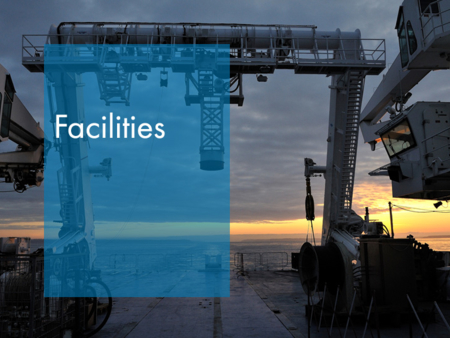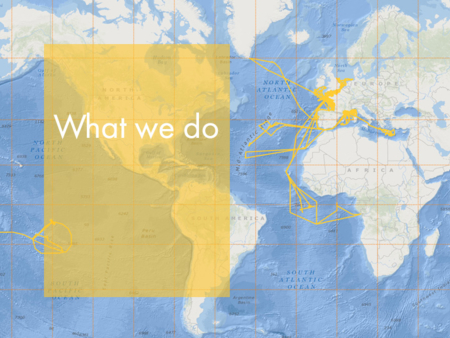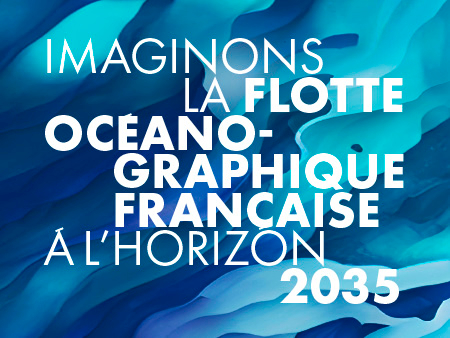- Length overall: 107.60 m
- Beam: 20 m
- Draught: 6.90 m
- Displacement: 6600 tonnes
- Gross tonnage: 7854 UMS
- Net tonnage: 2356 UMS
- Bureau Veritas classification: Class 1, special service, deep sea, ALP, ALM, ALS, AUT-IMS, AUT - PORT, SYS-NEQ-1, DYNAPOS AM/AT R, COMF-G1.
- Stabilization: flume tank, capacity 49 m3
- Crew: 17–33
- Scientists and technicians: 40 max
- Maximum number of people aboard: 75
- Average operating speed during passages and cruises: 11 knots
- Maximum speed: 14.5 knots
- Range: 64 days at 11 knots
- Construction: 2005, Alstom Leroux Naval, Saint Nazaire
- Owner: IFREMER
- Operator: Genavir
- Flag: France
- Type: Deep-sea oceanographic research vessel.
- Call Sign: FMCY
- MMSI number: 228 207 600
- Registry number: BR 925 375
- IMO number: 9285548
- Multibeam echo sounder for shallow water 100 kHz
- Multibeam echo sounder for deep water 12 kHz et 24 kHz
- Single-beam echo sounder, EA600, frequency range 12.38–200 kHz
- Acoustic Doppler current profiler, ADCP : 38 kHz and 150 kHz
- Inertial navigation system: IXSEA – PHINS
- Sub-bottom profiler
- Bathythermograph
- Gravimeter: KSS 32M Bodenseewerk
- Ultra-short baseline: Posidonia – Ixsea
- Magnetometer: SEASPY
- Acoustic remote-control unit: TT801 – Ixsea
- Thermosalinograph: SBE 21 Seabird
- Temperature sensor: SBE 38 Seabird
- CTD profiler: SBE19 Seabird
- Pinger: Sepia - Sercel
- Master synchronizer: ACEB M90
- Sound velocity sensor
- Weather station: Batos - Météo France
- Noise and vibration analyser: Sabrina – IFREMER
- Synchronization of acoustic equipment: OSEA – IFREMER
- CTD profiler
- Scientific Operations Room (90 m²)
- Conference Room (63 m²)
- Data Processing Room (80 m²)
- Mission Equipment Room
- Scientific Instrument Room (60 m²)
- Multipurpose Wet Laboratory (27m²)
- Wet Hydrology Laboratory (35 m²)
- Dry Hydrology Laboratory (10 m²)
- Holding and Culture Laboratory +2°C20°C (13 m²)
- Dry Analytical Laboratory
- Common Preparation Room
- Clean Chemistry Laboratory
- Clean Biology Laboratory
- Meteorological Measurements Laboratory
- Core Storage Cool Room +4°C
- Sample Storage Cold Room -20°C (8 m²)
- Afterdeck – Hangar
- Layouts of the scientific areas
Scientific Operations Room
The Scientific Ops Room is where scientific data is acquired and monitored in real time. It is also mission command and control. It is divided into three distinct zones:
- Mission Watch Zone: a multipurpose area for conducting operations and monitoring various equipment in real time.
- Data Acquisition and Monitoring Zone: Attached to the Mission Watch Zone, this area is where data is monitored, acquired and archived.
- Submersibles Watch Zone: An isolated area where watch members carry out scientific work in real time on devices in the water (ROV, manned submersible, towed sonar, etc.).
Conference Room
This multipurpose mission room is dedicated to meetings, conferences, videoconferences and the projection of scientific video. It has a capacity of forty people. It contains a large meeting table, seats and chairs, a conference cabinet, an overhead projector, a video-projector and a projection screen.
Data Processing Room
This room is dedicated to preparing operations, surveys and dives, and post-processing data.
It contains work surfaces and desks grouped together in areas separated by low partitions.
Mission Equipment Room
This mission room is devoted to the packing and maintenance of scientific equipment and large device subsystems. The role of this room is decided in the preparatory meeting, and depends on the type of cruise and which rooms are available. The needs of the mission leader and the crew of the ship-borne submersible must also be taken into account.
Scientific Instrument Room
Access to this room is through the mission equipment room. This room is dedicated to preparing and maintaining scientific equipment such as electronic enclosures, electronic charts, and the electromechanical components of small subsystems of various pieces of equipment.
Multipurpose Wet Laboratory
Biological and geological samples pass through the wet lab first when they come aboard. A rock cutter and core specimen bench can be installed in the wet lab. It can be turned into a laboratory for preparing equipment or an analytical laboratory. The laboratory floor can be washed down with a hose. It communicates with the starboard passageway, the hangar via a door featuring a removable coaming, and the wet hydrology laboratory.
A service lift connects this laboratory with the upper level (common room).
Wet Hydrology Laboratory
This wet lab is where the profilers are maintained and packed, water is sampled and analysed, and cores are worked on. It can also be used for operations to sort and pack fauna, as well as all the “clean” biological operations that require the handling of liquids.
The CTD profiler is brought to the laboratory from the landing point under the hydrology-CTD gantry in the starboard passageway using a telescopic beam (WLL 1 tonne).
It communicates with two special rooms: the dry hydrology laboratory and the holding and culture laboratory.
Dry Hydrology Laboratory
This lab is dedicated to the acquisition of data from physical and chemical sensors, archiving data from biological and geological sorting, and optical microscopy.
The lab has a large window which provides a view of the CTD landing point from the wet hydrology lab and outside.
Holding and Culture Laboratory
This temperature-controlled laboratory (+2–20 °C) is dedicated to the culture and breeding of living organisms in aquariums supplied with running seawater.
Dry Analytical Laboratory
This laboratory is dedicated to analysing and processing samples, and to other various chemical and biological analyses.
It communicates with the wet hydrology laboratory.
Common Preparation Room
This room serves as the access trunk for the clean biology and chemistry laboratories. It contains mostly the cold chain equipment used for conserving samples.
This room communicates with the multipurpose wet laboratory (main deck) via a service lift.
Clean Chemistry Laboratory
This laboratory features an isolated zone built to cleanliness class P 100000 criteria of Federal Standard 209 E and the standard ISO 14644-8. This laboratory enables the analysis of chemicals in good conditions of cleanliness. Its use is restricted to the works concerned by these criteria and standards.
It can be air-conditioned to between 4 °C and 20 °C.
Clean BiologyLaboratory
Ce laboratoire est réservé exclusivement aux analyses biologiques, microbiologiques et aux études in vivo.
Meteorological Measurements Laboratory
This laboratory is dedicated exclusively to meteorological measurements.
Core Storage Cool Room (+4°C)
This room is refrigerated to +4 °C for storing samples and in particular core samples.
The floor of this room houses seven crates (1.20 m x 1 m), supplied by the mission, which amounts to stowage for 350 metre-long cores (diam. 11 cm) or 540 archive boxes. Another part of the room is fitted with adjustable stainless-steel shelving. No provision is made for stacking the crates. Crates are loaded manually when needed. Crates are unloaded when alongside, using a forklift. Lashings must be checked by the ship’s crew (a lashing system is available for lashing the crates).
Sample Storage Cold Room (-20°C)
This room is refrigerated to -20 °C for storing samples.
- This room is fitted with adjustable stainless-steel shelving.
- It is designed for storing samples collected during several cruises which are ready for landing (request to be made during the cruise preparation meeting).
- Access is through a trunk maintained at +4 °C and linked to the ship’s alarm system.
Afterdeck – Hangar
- Hangar with mezzanine overlooking the laboratories
- Afterdeck and starboard passageway
- Afterdeck
Layouts of the scientific areas of the Pourquoi pas ?
- Articulated stern gantry – 22 tonnes
- Oceanographic crane
- 1 winch, 8 tonnes radius 13 metres at sea, or 5 tonnes radius 15 metres at sea
- 1 winch, 2 tonnes radius 15 metres at sea
- Handling crane (STBD hangar)
- 15 tonnes radius 15 metres alongside
- 3 tonnes radius 15 metres at sea
- 0.5 tonne radius 22 metres with telescopic boom at sea
- Crane PORT AFT
- 15 tonnes radius 12 metres alongside
- 3 tonnes radius 12 metres at sea
- Lateral telescopic boom
- anchor point for deep-water block – 15 tonnes per part radius 4 metres off STBD side (core sampling, Penfeld, Victor)
- 1 winch 8 tonnes, and 1 winch 2 tonnes
- Hydrology/CTD gantry
- WLL 4 tonnes at sea with overhang of 3.5 metres on STBD
- 8000 metres of cable on both cable drums
- Mobile winch 5 tonnes
- two twin capstans WLL 15 tonnes
- four reels for 10000 m of cable including two compatible with EOP cable
- Hangar overhead crane
- WLL 2 tonnes
- used at sea
- Telescopic boom hydrology lab 1 tonne
Network: 720 sockets, 1 Gbps and 10 Gbps. Wi-Fi throughout the ship. Renewed in 2018.
Servers and data storage: VMWare virtualization, 20 TB of storage for scientific data, 6 stations for data processing.
Monitoring: Wall of 20 screens connected via an Avocent analogue empty array to all the acquisition and operating stations.
Satellite communications: C band VSAT (2.4 m) and FBB 500.
Software
- Acquisition and archiving unit: Techsas
- SMF data processing: Caraibes et Globe
- Submersibles video and data processing: ADELIE
- Information and video display aboard ship: Techsas
- Scientific logbook: CASINO+
- Integrated navigation system:
- CINNA (Genavir)
- Manta 2000 model manufactured by Kelvin Hughes
- ECDIS: VDR-A20 (Manta ECDIS Processor) – Kelvin Hughes
- Automatic identification system (AIS): NIS 2002 Mk2 – Kelvin Hughes
- Autopilot: AD2 – C-Plath
- DGPS (navigation): MX420/2 – Leica (x2)
- DGPS (scientific): Aquarius2 22 – Thales (x2)
- Doppler log (dynamic positioning): WHN 1200-1 – RDI
- Doppler log (navigation): Skipper DL 850 – Skipper
- Navigation echo sounders: GSD 101U 50 and 200 kHz – Skipper
- Argos direction finder: IESM Gonio 400 P aerial
- Gyrocompass: Octans model made by Ixsea (x2)
- Inertial navigation system: Phins model made by Ixsea
- Magnetic compass: GS 720 MK 2000 model made by Kelvin Hughes
- Dynamic positioning: DP class 2 made by Converteam
- S-band radar: Manta 2000/2300 model made by Kelvin Hughes
- X-band radar: Manta 2000/2300 made by Kelvin Hughes
- VHF radio direction finder: TD-L 1620A model made by Taiyo
- Voyage data recorder: NDR 2002 model made by Kelvin Hughes
- Anemometers: WindObserver II model made by Gill Instruments
- Electricity generation: 4 diesel generators alternators (4 x 1460 kW)
- Main propulsion: 2 electric motors, alternating current (2 x 1650 kW)
- Thrusters: 4 lateral thrusters, variable pitch propeller, 3 forward, 1 aft (4 x 735 kW)
- Diesel capacity: 1233 m3
- Freshwater capacity: 328 m3
- Drinking water capacity: 25 m3
- Freshwater production: 45 m3 per day
- Constant and uninterruptible 230 V supply: 2 UPS of 80 kVA
- GMDSS radio console, 3 sea areas
- Navtex receivers
- Radio call sign FMCY
- Telephone via Itineris GMS (8 W)
- Satellite communications:
- Fleet System
- VSAT
- Telex via Inmarsat
- Weather fax receiver




